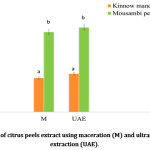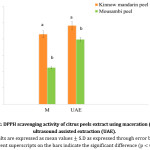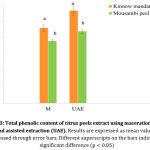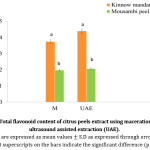Introduction
India produces varied range of fruits and vegetables and is second largest vegetable as well as third largest fruit producer in the world. Therefore, the processing of fruit and vegetable play a significant role in the growth of Indian food processing sector. However, this large quantities of waste is generated throughout the year in the form of peel, pulp, seeds and rags.1-3 Amongst all, peel is the main byproduct and constitutes abundant quantities of various bioactive components such as carotenoids, flavonoids and phenolic acids etc.4
Natural products from biological origin, such as extracts from plants have potential role in the development of various drugs and in the prevention of different diseases such as cancer, obesity and atherosclerosis etc. It was reported that bitter melon extract had an anti-tumor activity and anti-proliferative effect on the breast tumor and cancer cell growth.5,6 Moreover, bitter melon extract also have therapeutic effects in HNSCC (Head and neck squamous cell carcinoma) by enhancing the effector functions of immune system.7,8
Among all fruits, citrus fruits are the third most important fruit crop grown in tropical and subtropical regions of the world. According to US Food and Agriculture Organization report 2017, the annual production of citrus fruits is approximately 124 million tonnes. Citrus fruit processing generates large quantities of waste which accounts for approximately 50% of their weight. Flavonoids are the major category of phytochemicals present in citrus peels.9 These bioactive compounds in natural products have various health properties such as anti-inflammatory, anti-carcinogenic activity, antioxidant and anti-allergic, etc., which can add value in food, pharmaceutical and nutraceutical industry.10 Moreover, these functional compounds have benefits in food industry e.g. inhibiting the oxidation of lipids and rancidity.11
Extraction of these compounds as a natural product from peels is the suitable alternative for valorization of wastes generated from different processing industry; thereby leading to the development of cost effective processes. 12 Various research studies have been conducted on extraction of bioactive compounds by conventional and non-conventional methods (green techniques) such as maceration, soxhlet extraction, microwave, supercritical fluid extraction, ultrasound extraction etc., each having its own advantages as well as disadvantages. For example the extraction of bioactive components at the optimal UAE condition provided the maximum yield (26.52%) and total phenolic content (15,263.32 mg Eq gallic/100 g DW) from Citrus reticulata Blanco cv. Sainampueng peel. Therefore, under same extraction conditions, UAE showed higher extraction efficiency in terms of yield, which was 1.77 times higher than MAE.13 Moreover, different combinations of non-conventional techniques such as extraction based on ionic liquids through simultaneous ultrasonic and microwave assisted extraction have higher efficiency than conventional heat-reflux extraction method for phenolic compounds from burdock leaves.14 In addition, blanching was carried out by conventional and ultrasound methods as the pretreatment method before drying. The highest retention of vitamin C (37.5-85%) was obtained by conventional method at high temperature whereas organoleptic quality was maintained by ultrasound method.15 Another study showed that phycocyanin yield from Spirulina platenis was found higher (13.61%) using UAE as compared to conventional technique (11.13%).16 It was reported that ultrasonic parameters such as temperature, time and power had a profound effect on the total phenolic content and antioxidant capacity of Euphorbia tirucalli leaf which revealed that ultrasonic time had least impact for extraction of TPC and antioxidant capacity.17 Similarly, the extraction of glycryrrhizic acid from the Clycyrrhiza glabra L. showed that ultrasound method was better than mechanical stirring method.18
Recently, focus has been shifted towards the use of green extraction technique due to their higher extraction efficiency and less degradation of phenolic compounds at much higher extraction rate.19-21 Among all green extraction techniques, ultrasound assisted extraction has gained more attention because of their wide range of applications in different sectors.20
In view of the above, this study was focused on the extraction of phytochemicals from the citrus peels using two different techniques, viz. maceration as well as ultrasound assisted extraction and their antioxidant capacity.
Material and Methods
Citrus Peels
Peels of two different fully ripened citrus species, viz. (Citrus reticulata) cv. ‘kinnow mandarin’ and (Citrus limetta) cv. ‘mousambi’, were collected from the local market in Longowal, India. Citrus peels from two cultivars were dried separately in a tray dryer at 50°C and ground in fine powder and stored at -20°C
Chemicals
The various chemicals used in this study (2,2-diphenyl-1-picrylhydrazyl (DPPH), Folin-Ciocateu reagent, sodium bicarbonate (Na2CO3), gallic acid, catechin and aluminium chloride) were procured from Sigma Chemicals (Germany), HiMedia (India) and Merck (US).
Extraction
Powdered dried sample (20 g) was taken from Citrus reticulata (kinnow mandarin) and Citrus limetta (mousambi) peels, respectively. The extraction from citrus peels was carried out by maceration and UAE technique using acetone (100%, w/v). Samples were mixed with acetone (1: 3) and kept for 30 min at room temperature (37±1°C) until the clear extract was obtained after sequenced filtration.22 The extract was filtered and evaporated by rotary evaporator. Acetone was used as a solvent due to their strong polarity and volatility in order to improve the yield and concentrate the desired compounds. Various citrus peels extracts (CPE) were dissolved in methanol and kept at -20°C in benzene with air tight container for determination of antioxidant properties.
Yield (%): The yield (%) of the samples was calculated as:
![]()
Estimation of Polyphenols, Flavonoids and Antioxidant Activity
Total phenolic content was estimated using Folin–Ciocalteu regent.23 The total phenolic content was calculated from a calibration curve with pure gallic acid as standard. The results were expressed as gallic acid equivalents (GAE), in mg/g dry extract. Total flavonoids were determined by aluminium chloride method.24 Results were expressed as mg catechin equivalent per gram dry weight of the samples. The DPPH radical scavenging activity of citrus peels was measured.25 The DPPH radical scavenging activity was calculated from the following formula:
% DPPH radical scavenging activity =
![]()
Statistical Analysis
In order to study the effect of multiple replicates, the extraction treatment was carried out in triplicates under the same conditions. The data obtained from the analysis of extracts was analyzed by using GraphPad Prism (version 5.01, La Jolla, CA, USA) software and results are expressed as mean ± standard deviation. Difference between the mean values was tested for the statistical significance using a two-way ANOVA (analysis of variance). The significance level was set at 5% (P < 0.05) for all calculations.
Results
The efficiency of both techniques, such as maceration and UAE for the extraction of phenolic components in terms of yield and its various properties has been discussed in the following sections.
Extraction Yield
The yield of each sample was recorded in the range of 5.20 to 12.95% on the dry basis of sample weight by using maceration and UAE method as presented in Fig. 1. The maximum extraction yield of 12.95% and 5.85% was obtained from mousambi and kinnow mandarin peels, respectively by UAE method. In contrast to the above, the maximum extraction yield by using maceration technique was 5.20% and 12.20% for kinnow mandarin and mousambi peels respectively.
DPPH Free Radical Scavenging Activity
The DPPH scavenging activity of each sample was investigated and scavenging activity was found in the range of 22.46 to 48.23% on the dry basis of sample weight by using maceration and UAE method as presented in Fig. 2. The maximum DPPH activity of 48.23% and 39.73% was obtained from kinnow mandarin and mousambi peels, respectively by UAE method. In contrast to the above, the maximum DPPH activity using maceration technique was 42.96% and 22.46% for kinnow mandarin and mousambi peels respectively.
 |
Figure 1: Yield of citrus peels extract using maceration (M) and ultrasound assisted extraction (UAE). Click here to View figure |
 |
Figure 2: DPPH scavenging activity of citrus peels extract using maceration (M) and ultrasound assisted extraction (UAE). Click here to View figure |
Total Phenolic Content (TPC)
The total phenolic content was obtained in the range of 19 to 28.3 mg GAE/g DW on the dry basis of sample weight by using maceration and UAE method as presented in Fig. 3. The maximum phenolic content of 28.30 mg GAE/g DW and 21.79 mg GAE/g DW was obtained from kinnow mandarin and mousambi peels, respectively by UAE method. In contrast to the above, the total phenolic content using maceration technique was 23 mg GAE/g DW and 19 mg GAE /g DW for kinnow mandarin and mousambi peels respectively.
Total Flavonoid Content (TFC)
The total flavonoid content was found in the range of 1.98 to 4.40 mg CE/g DW using maceration and UAE method as presented in Fig. 4. The maximum flavonoid content of 4.40 mg CE/g DW and 2.07 mg CE/g DW was obtained from kinnow mandarin and mousambi peels, respectively by UAE method. However, the maximum flavonoid content by using maceration technique was 3.75 mg CE/g DW and 1.98 mg CE/g DW for kinnow mandarin and mousambi peels respectively. These results showed that UAE method have given better results as compared to maceration method at ambient conditions.
 |
Figure 3: Total phenolic content of citrus peels extract using maceration (M) and ultrasound assisted extraction (UAE). Click here to View figure |
 |
Figure 4: Total flavonoid content of citrus peels extract using maceration (M) and ultrasound assisted extraction (UAE). Click here to View figure |
Discussion
This study was undertaken to assess the efficiency of maceration as well as ultrasound technique for the extraction of polyphenols from the citrus peels, viz., kinnow mandarin and mousambi peels. Amongst all, UAE proved to be the best method that resulted in higher yield of phenolic compounds from kinnow mandarin peels.
The mean yield of acetone extract was 12.20 % and 5.20% by using maceration obtained from kinnow mandarin and mousambi peels, respectively. These results are in close agreement with the study carried out by previous researchers.26-27 The mean yield of kinnow mandarin peels extract was increased from 5.20 to 5.85% while in mousambi peels extract; mean yield was enhanced from 12.20 to 12.95% by using ultrasound assisted extraction.
Comparative studies were undertaken among the fresh and concentrated juice of blood orange; both stored at -20°C. The DPPH activity of both concentrated and non-concentrated juices varied from 39.16 to 33.75% and 53.39 to 42.55%, respectively. Although, the anthocyanain content decreased in both the juices, however, the concentration was found to be higher in non-concentrated juice. The results indicated that concentration and duration of storage had a profound effect on the physicochemical properties of the blood orange juice.28 Similarly, antioxidant properties of the fresh and the frozen peels of the different citrus species revealed that frozen peels of the citrus species were rich in potent antioxidants. This may be attributed to the fact that during freezing, bound phenolic compounds are released from cellular part from the peels at greater extent as compared to fresh peels.29-30
The concentration of phenolic compounds of 28.30 mg GAE/g DW and 21.79 mg GAE/g DW was obtained from kinnow mandarin and mousambi peels, respectively using UAE method. Moreover, maximum flavonoid content of 3.75 mg CE/g DW and 1.98 mg CE/g DW was obtained from kinnow mandarin and mousambi peels, respectively by maceration method. Nevertheless, the maximum flavonoid content of 4.40 mg CE/g DW and 2.07 mg CE/g DW was obtained from kinnow mandarin and mousambi peels, respectively through UAE method. The scavenging activity of 42.46% and 22.46% has been recorded by maceration while 48.23% and 39.73% was found via UAE from various citrus peels. Therefore, in contrast to the maceration, UAE increased the extract yield as well as polyphenol content from citrus peels due to cavitation effect which accelerates the release of compounds and increases the mass transfer process through distorting the cell wall of plants.26,31 Extraction of flavonoids and ascorbic acid from lemon fruits revealed that the techniques used for the extraction also had an impact on the yield of these compounds.32
Among these two citrus cultivars, the kinnow mandarin peels have higher antioxidant properties than mousambi peels with UAE, which can be due to the variation in chemical composition, maturity level at harvesting, different cultivar (genotype) like Castagnaro, Fantastico and Femminello and conditions of soil and post harvest storage.33-34 The experimental data have indicated that scavenging activity of citrus peels extract varied significantly among different cultivars. Among both cultivars of citrus fruits, peels of kinnow mandarin have high DPPH scavenging activity as compared to mousambi using maceration as well as UAE technique. It may be due to the degree of ripeness (ripe or unripe) that has a strong influence on the presence of different bioactive compounds such as phenolic acids, flavonoids, etc.35
Conclusion
The present investigation indicated the efficiency of non-conventional (UAE) technique for the extraction of the polyphenols from peels of different citrus cultivars. In contrast to the maceration technique, total extraction yield, DPPH scavenging activity, phenolic content as well as flavonoids was found higher with UAE method. Being abundant in phytochemicals with antioxidant properties, these can be used as potential ingredients for the development of functional foods. Thus, this study indicates the potential of UAE over the maceration technique in terms of yield, total phenols, total flavonoids and antioxidant capacity of citrus peels extract. Moreover, UAE is advantageous because of its simplicity, reduced operational time, less toxic, minimum energy as well as solvent consumption; thereby leading to the development of an economical process for the extraction of bioactive compounds. Therefore, UAE technique has wider applications in industrial sector as compared to conventional techniques. In addition, valorization of agro-industrial residues for the extraction of value added products not only solves the disposal problem, but also makes the process economical.
Acknowledgements
The authors acknowledge the support and lab facilities provided by the Sant Longowal Institute of Engineering and Technology, Longowal (Sangrur), India.
Funding
The author(s) received no financial support for the research, authorship, and/or publication of this article.
Competing Interests
The authors have no conflict of interest
References
- United States Food and Drug Administration (FDA). Citrus: World Markets and Trade, Agriculture –Foreign Agricultural Service. United States, 2011.
- Food and Agriculture Organization of the United Nations (FAO). Citrus Fruit: Fresh and Processed –Annual Statistics. United States, 2010.
- Braddock R. By-products of citrus fruit. Food Technol. 1995;49:74-77.
- Manthey J. A., Grohmann K. Phenols in citrus peel byproducts. Concentrations of hydroxycinnamates and polymethoxylated flavones in citrus peel molasses. J Agric Food Chem. 2001;49(7):3268-3273.
CrossRef - Ray R. B., Raychoudhuri A., Steele R., Nerurkar P. Bitter melon (Momordica charantia) extract inhibits breast cancer cell proliferation by modulating cell cycle regulatory genes and promotes apoptosis. Cancer Res. 2010;70:1925-31.
CrossRef - Muhammad N., Steele R., Isbell T. S., Philips N., Ray R. B. Bitter melon extract inhibits breast cancer growth in preclinical model by inducing autophagic cell death. Oncotarget. 2017;8(39):66226-66236.
CrossRef - Bhattacharya S., Muhammad N., Steele R., Kornbluth J., Ray R. B. Bitter Melon enhances natural killer–Mediated toxicity against head and neck cancer cells. Cancer Prev Res. 2017;10(6):337-344.
CrossRef - Bhattacharya S., Muhammad N., Steele R., Peng G., Ray R. B. Immunomodulatory role of bitter melon extract in inhibition of head and neck squamous cell carcinoma growth 2016;7:33202-33209.
CrossRef - Wang Y. C., Chuang Y. C., Hsu H. W. The flavonoid, carotenoid and pectin content in peels of citrus cultivated in Taiwan. Food Chem. 2008;106:277-284.
CrossRef - Liu R. H. Potential synergy of phytochemicals in cancer prevention: Mechanism of action. J Nutr. 2004; 134(12):3479S-3485S.
CrossRef - Procházková D., Boušová I., Wilhelmová N. Antioxidant and prooxidant properties of flavonoids. Fitoterapia. 2011; 82:513-523.
CrossRef - Saini A., Panesar P. S., Bera M. B. Valorization of fruits and vegetables waste through green extraction of bioactive compounds and their nanoemulsions-based delivery system. Bioresour Bioprocess. 2019;6:26. https://doi.org/10.1186/s40643-019-0261-9
CrossRef - Nipornram S., Tochampa W., Rattanatraiwong P., Singanusong R. Optimization of low power ultrasound-assisted extraction of phenolic compounds from mandarin (Citrus reticulata Blanco cv. Sainampueng) peel. Food Chem. 2018;241:338-345.
CrossRef - Lou Z., Wang H., Zhu S., Chen S., Zhang M., Wang Z. Ionic liquids based simultaneous ultrasonic and microwave assisted extraction of phenolic compounds from burdock leaves. Anal Chim Acta. 2012;716:28-33.
CrossRef - Gamboa-Santos J., Cristina Soria A., Pérez-Mateos M., Carrasco J. A., Montilla A., Villamiel M. Vitamin C content and sensorial properties of dehydrated carrots blanched conventionally or by ultrasound. Food Chem. 2013;136(2):782-788.
CrossRef - Hadiyanto H., Suttrisnorhadi S. Response surface optimization of ultrasound assisted extraction (uae) of phycocyanin from microalgae spirulina platensis. EJFA. 2016;28(4):227-234.
CrossRef - Vuong Q. V., Goldsmith C. D., Dang T. T., Nguyen V. T., Bhuyan D. J., Sadeqzadeh E., Scarlett C. J., Bowyer M. C. Optimisation of ultrasound-assisted extraction conditions for phenolic content and antioxidant capacity from Euphorbia tirucalli using response surface methology. Antioxidants. 2014;3(3):604-617.
CrossRef - Giuffrè A. M. Influence of time and method in glycyrrhizic acid extraction from roots of Licorice spontaneous plants (Clycyrrhiza glabra L.). Ind Aliment. 2013;52(539):23-27.
- Herrera M. C., Luque de Castro M. D. Ultrasound-assisted extraction of phenolic compounds from strawberries prior to liquid chromatographic separation and photodiode array ultraviolet detection. J Chromatogr A. 2005;1100(1):1-7.
CrossRef - Ma Y. Q., Chen J. C., Liu D. H., Ye X. Q. Effect of ultrasonic treatment on the total phenolic and antioxidant activity of extracts from citrus peel. J Food Sci. 2008;73(8):115-120.
CrossRef - Papoutsis K., Pristijono P., Golding J. B., Stathopoulos C. E., Bowyer M. C., Scarlett C. J., Vuong Q. V. Screening the effect of four ultrasound-assisted extraction parameters on hesperidin and phenolic acid content of aqueous citrus pomace extracts. Food Biosci. 2018;21:20-26.
CrossRef - Elfalleh W., Hannachi H., Tlili N., Yahia Y., Nasri N., Ferchichi A. Total phenolics conents and antioxidant activities of pomegranate peel, seed, leaf and flower. J Med plants Res. 2012;6:4724-30.
CrossRef - Singleton V. L., Orthofer R., Lamuela-Raventos R. M. Analysis of total phenols and other oxidation substrates and antioxidants by means of Folin-Ciocalteu reagent. Methods Enzymol. 1999;299:152-178.
CrossRef - Liu H., Qiu N., Ding H., Yao R. Polyphenols contents and antioxidant capacity of 68 Chinese herbals suitable for medical or food uses. Food Res Int. 2008;41:363-370.
CrossRef - Yi Z., Yu Y., Liang Y., Zeng B. In vitro antioxidant and antimicrobial activities of the extract of Pericarpium Citri Reticulatae of a new Citrus cultivar and its main flavonoids. LWT- Food Sci Technol. 2008;41:597-603.
CrossRef - Safdar M. N., Kausar T., Jabbar S., Mumtaz A., Ahad K., Saddozai A.A. Extraction and quantification of polyphenols from kinnow (Citrus reticulate L.) peel using ultrasound and maceration techniques. J Food Drug Anal. 2017;25(3):488-500.
CrossRef - Babbar N., Oberoi H. S., Uppal D. S., Patil R. T. Total phenolic content and antioxidant capacity of extracts obtained from six important fruit residues. Food Res Int. 2011;44(1):391-396.
CrossRef - Giuffrè A. M., Zappia C., Capocasale M. Physicochemical stability of blood orange juice during frozen storage. Int J Food Prop. 2017;20(sup2):1930-1943.
- Azman N. F. I. N., Azlan A, Khoo H. E., Razman M. R. Antioxidant properties of fresh and frozen peels of citrus species. Curr Res Nutr Food Sci. 2019; 7(2). http://bit.ly/2MegF2C
CrossRef - Minatel I. O., Borges C. V., Ferreira M. I., Gomez H. A. G., Chen C. Y. O., Lima G. P. P. Phenolic compounds: Functional properties, impact of processing and bioavailability. London, United Kingdom: InTech; 2017.
CrossRef - Chemat F., Rombaut N., Sicaire A. G., Meullemiestre A., Fabiano-Tixier A.S., Abert-Vian M. Ultrasound assisted extraction of food and natural products. Mechanisms, techniques, combinations, protocols and applications. A review. Ultrason Sonochem. 2016;34:540-560.
CrossRef - Marı́n F., Martinez M., Uribesalgo T., Castillo S., Frutos M. Changes in nutraceutical composition of lemon juices according to different industrial extraction systems. Food Chem. 2002;78(3):319-324.
CrossRef - Giuffrè, A. M. Bergamot (Citrus bergamia, Risso): The effects of cultivar and harvest date on functional properties of juice and cloudy juice. Antioxidants. 2019;8(7):221.
CrossRef - Roginsky V., Lissi E. A. Review of methods to determine chain-breaking antioxidant activity in food. Food Chem. 2005;92(2):235-254.
CrossRef - Omoba O., Obafaye R., Salawu S., Boligon A., Athayde M. HPLC-DAD phenolic characterization and antioxidant activities of ripe and unripe sweet orange peels. Antioxidants. 2015;4(3):498-512.
CrossRef

This work is licensed under a Creative Commons Attribution 4.0 International License.







